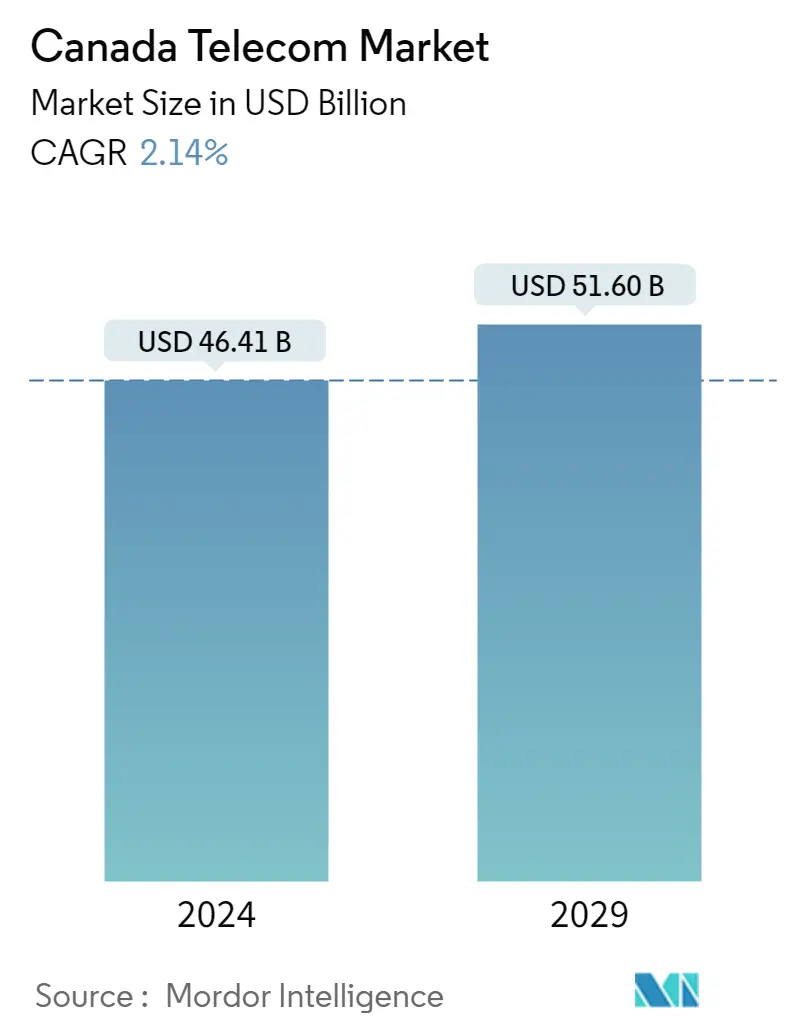Market Size of Canada Telecom Industry

| Study Period | 2019 - 2029 |
| Base Year For Estimation | 2023 |
| Market Size (2024) | USD 46.41 Billion |
| Market Size (2029) | USD 51.60 Billion |
| CAGR (2024 - 2029) | 2.14 % |
| Market Concentration | Low |
Major Players
*Disclaimer: Major Players sorted in no particular order |
Canada Telecom Market Analysis
The Canada Telecom Market size is estimated at USD 46.41 billion in 2024, and is expected to reach USD 51.60 billion by 2029, growing at a CAGR of 2.14% during the forecast period (2024-2029).
The Canadian telecoms sector experienced much activity in the last year. The telecom market witnessed various industry-friendly regulatory decisions in the first half of 2021. Furthermore, the telecom sector in Canada changed how people in the country interact with one another, conduct business, and have fun. It also fueled economic development and innovation and assisted in the fight against global warming.
- According to the Canadian Wireless Telecommunications Association (CWTA)/Accenture report, the introduction of 5G networks and services in Canada by 2026 will enhance GDP by an additional USD 40 billion and create 250,000 long-term jobs. It will also cost wireless carriers worth USD 26 billion. With significant expenditures made by Canadian facilities-based carriers, businesses that design and manage the country's top-notch wireless networks determine Canada's position as a global leader in wireless technology. Bell, Rogers, TELUS, Shaw/Freedom, Videotron, SaskTel, Eastlink, Xplore Mobile, and Tbaytel are examples of facilities-based carriers.
- Canada's facilities-based carriers put in place arguably the world's fastest and most dependable wireless networks, covering every province and territory, despite the country's population being dispersed across enormous areas. Canada is a "4G superpower," according to independent network analyst Opensignal, and there are few other countries that are better positioned than Canada to develop 5G networks of the future. According to a CWTA report, the full-fledged implementation of 5G in the country will support a thousand times traffic increase between 2020 and 2030.
- Canadian telecommunication services are used by other businesses to create and market goods and services. Thus, it significantly impacts the Canadian economy. Many industries, including the arts and transportation, saw significant income decreases due to the COVID-19 pandemic. Despite these market effects, telecommunications investments and infrastructure could accommodate new telecommunications connections that allowed all industries (other than telecoms) to contribute a total of USD 47.9 billion in direct GDP to Canada's economy in 2021. These telecommunication advantages were most noticeable in the fields of healthcare and education.
- The speed and coverage of Canada's top mobile wireless networks enable Canadians to use more wireless data. According to a CWTA projection, this growth will last for the foreseeable future. The average data usage per subscription with a data plan (GB/month) increased from 1.5 GB in 2026 to 5.3 GB in 2021. Encouragingly, the prices for these plans keep dropping as many customers move to better data plans. The price for 2GB data plans decreased by 41% in five years. Meanwhile, 5GB data plans dropped by 44% in five years, 10 GB plan dropped by 19% in two years, and 20 GB plans declined by 9% in one year. The price for the 50 GB plan also decreased by 26% in a year.
- The COVID-19 outbreak brought attention to how crucial connectivity is to Canadian society, commerce, and economy. With the continuous, accelerated growth in digital traffic, Canada's facilities-based operators continued to invest in expanding capacity and improving essential telecommunication services and infrastructure, laying the groundwork for a robust post-pandemic economic rebound. The telecommunications sector functioned in pace with the overall economy, keeping its percentage of the total Canadian GDP output. According to Accenture's analysis, the telecommunications sector's contribution to the GDP and the number of employments it supported might soon reach USD 70.7 billion and up to 596,000, respectively. The industry made more than USD 11 billion in growth and innovation of the infrastructure during this time. The shock of COVID-19 brought on a potentially long-lasting change in Canadian society and corporate operations.
Canada Telecom Industry Segmentation
The study provides an in-depth analysis of the telecommunication industry in Canada. The Canadian telecom market is segmented by services, which is further classified into voice services (wired, wireless), data and messaging services, and OTT and pay TV.
| Segmentation by Services (Coverage to include Average Revenue Per User for the overall Services segment, Market size and Estimates for each segment for the period of 2020-2027 and in-depth Trend Analysis) | ||||
| ||||
| Data and Messaging Services (Coverage to include Internet & Handset Data packages, Package Discounts) | ||||
| OTT and Pay-tv Services |
Canada Telecom Market Size Summary
The Canadian telecom market is poised for steady growth, driven by advancements in wireless technology and significant investments in infrastructure. The sector has undergone substantial transformation, influencing how Canadians communicate, conduct business, and engage in entertainment. The introduction of 5G networks is expected to play a pivotal role in this evolution, enhancing connectivity and enabling new use cases across various industries. Canadian facilities-based carriers, such as Bell, Rogers, and TELUS, are at the forefront of this transformation, investing heavily in developing robust wireless networks that span the country's vast geographical expanse. These efforts position Canada as a leader in wireless technology, with the potential to significantly boost the national economy and create numerous job opportunities.
The telecom industry in Canada is characterized by its fragmented nature, with major players like BCE Inc., Telus Communications Inc., and Shaw Communications Inc. competing alongside various ISPs and MVNOs. The market's competitive landscape is further enriched by strategic partnerships and technological collaborations, such as those between Telus and Google Cloud, and Rogers Communications and Microsoft. These alliances aim to leverage cutting-edge technologies like AI and cloud computing to enhance service offerings and operational efficiency. As the demand for faster and more reliable connectivity continues to rise, the Canadian telecom sector is expected to maintain its critical role in supporting economic growth and innovation, while also addressing environmental challenges through improved energy efficiency and reduced carbon emissions.
Canada Telecom Market Size - Table of Contents
-
1. MARKET INSIGHTS
-
1.1 Market Overview
-
1.2 Industry Ecosystem Analysis
-
1.3 Industry Attractiveness-Porter's Five Force Analysis
-
1.3.1 Bargaining Power of Suppliers
-
1.3.2 Bargaining Power of Consumers
-
1.3.3 Threat of New Entrants
-
1.3.4 Threat of Substitute Products
-
1.3.5 Intensity of Competitive Rivalry
-
-
1.4 Impact of COVID-19 on the Industry Ecosystem
-
1.5 Regulatory Landscape in the Country
-
-
2. MARKET SEGMENTATION
-
2.1 Segmentation by Services (Coverage to include Average Revenue Per User for the overall Services segment, Market size and Estimates for each segment for the period of 2020-2027 and in-depth Trend Analysis)
-
2.1.1 Voice Services
-
2.1.1.1 Wired
-
2.1.1.2 Wireless
-
-
2.1.2 Data and Messaging Services (Coverage to include Internet & Handset Data packages, Package Discounts)
-
2.1.3 OTT and Pay-tv Services
-
-
Canada Telecom Market Size FAQs
How big is the Canada Telecom Market?
The Canada Telecom Market size is expected to reach USD 46.41 billion in 2024 and grow at a CAGR of 2.14% to reach USD 51.60 billion by 2029.
What is the current Canada Telecom Market size?
In 2024, the Canada Telecom Market size is expected to reach USD 46.41 billion.

